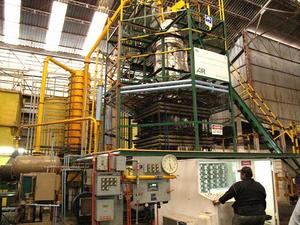
One company that is researching a novel way to turn waste into electricity is Plasma2Energy, a Texas-based technology company whose patented process can convert one ton of waste into 2200kWh of electricity, nearly three times the standard conversion rate of 815 kWh. That would be enough to power 1,400 homes in Texas, the company claims.
Plasma2Energy says its patented technology can also turn one ton of municipal solid waste (MSW) an hour to 3.14 barrels of crude oil. Considering the U.S. generates 251 million tons of trash per year and half of it ends up in landfills, then we can see we’re wasting a huge untapped source of energy.
Energy Refuge caught up with Teo Tijerina, Plasma2Energy’s vice president, and Rodolfo Sanchez, the company’s CEO, to find out more about the company’s technology whereby waste can become energy.

P2E: Plasma gasification is a waste to energy process that converts organic (carbon-based) waste into a syngas that can be used to make electricity or other products. Plasma gasification is different than combustion or incineration. Combustion (burning) uses oxygen to release energy from matter, while plasma gasification does not.
Traditional plasma gasification technology uses an electric arc or electric torch as the main component. A gas is passed through the high voltage arc, creating a plasma which is an ionized gas at very high temperatures. At these very high temperatures, the waste breaks up into its basic elemental components and is thus “gassified.” The free carbons react with oxygen to form Carbon Monoxide (CO) and free Hydrogens react with each other to form a Hydrogen molecule (H2). These two molecules become the main components of syngas.
Traditional plasma gasification technologies do not work well when water is present, so waste has to be dried before entering the reactor. Second, generating a high voltage to create a plasma field requires a lot of electricity; hence, the net electric gain is compromised. While plasma gasification technology has been around for decades, the economics do not yield positive ROI. Thus, it has been limited to specific industrial applications. As a solution to municipal waste, communities with a high cost of land or those that wish to subsidize the capital and operational requirements can justify investing into traditional plasma gasification technology.
Plasma2Energy utilizes a proprietary and patented technology that generates plasma using an entirely different approach. We use microwave radiation to form plasma from waste. The water contained in the waste, or injected water if necessary, is superheated and reacts with ionized carbon and hydrogen to create CO and H2 (syngas).
The use of microwave radiation to generate plasma and the subsequent reaction with water are the key differentiators in how Plasma2Energy is able to deliver a process that consumes very little electricity to operate and converts more of the waste into syngas than the traditional electric arc or electric torch technology.
(Continues below)

P2E: The economic impact is across several areas. First, our process creates value out of waste. A municipality that consumes the electricity produced will see many savings on their utility bill, and the total annual operating cost of generating those savings is low enough to justify a payback over time. With our technology, a municipality does not have to worry about “subsidizing” the plant. Second, a community saves tipping fees, and these can vary between $20 / ton – $80 / ton depending on the location. These tipping fees are charged by operators of landfills to pay for land, labor, and operations expenses. In the case where municipality owns the landfill, a waste to energy plant also extends the life of the landfill because it reduces or can eliminate the amount of annual waste into the landfill. Building new landfills are very expensive. In addition, even after landfills are closed, there are ongoing maintenance expenses and environmental liability concerns.
Another benefit is the inorganic (non-carbon based) waste, such as glass, dirt, metals, is a byproduct of the Plasma2Energy process which is inert, and can be used in construction materials. In addition, there are also job creation benefits. Daily operations of a waste to energy plant requires operators, technicians, engineers, and managers. Job creation has a trickle down effect on the community because of the local suppliers who will engage in business with the waste to energy plant.
Finally, the environmental benefits of plasma gasification over combustion is that CO2 is not created in the case of the former, so there are no harmful contaminants to the atmosphere. Improved environmental conditions also affect the long term health and costs of a municipality.
As a solution to waste, plasma gasification is a winning proposition for municipalities. The barrier to plasma gasification in the past was a high “parasitic” electrical consumption, which resulted in a low net electricity production, and investment dollars that could not be recuperated. Plasma2Energy has solved this problem.
ER: Do these plants have any harmful impact on people and wildlife nearby?
P2E: No, not at all. There are no emissions from the ABA process. If any, all pollutants and toxic elements are recovered in a liquid or solid form.
ER: You say China and Europe are leading the way in this sector. Why is that?
P2E: Europe and Japan have embraced traditional plasma gasification to some extent. This makes sense given their limited land availability and high population density. In terms of China’s recent emergence, China is investing into many different sectors of renewable energy and fuel. This can best be explained by a Government that understands the importance of having multiple sources of energy, and a government that has accumulated many U.S. dollars and is now looking to make investments and to become a technological leader. China appears to have a willingness to take risks on those dollars whereas the U.S. capital markets have moved away from early stage investing.
ER: What contribution can they make to wean us off oil?
P2E: Waste is a form of energy. If the United States can exploit this energy without losing money on it, we now have electricity from a renewable source. This impacts the demand for electricity from oil, which gets us one step closer to oil independence. A recent presentation by Dr. Louis J. Circeo, the Director of Plasma Applications Program at Georgia Tech University, indicated that approximately 5% of the United States’ electricity needs could be supplied by Municipal Solid Waste.






I am all for finding new sources of energy, but how does this truly affect global warming? If melting of the icecaps is a concern, how many cubic feet of water were offset from the earthquake. That water had to raise some. Not sure how much but I’m willing to guess it was more than the icecaps in recent years.
Thoughts?
PS – Great blog. I tend to read but no comment on the articles. Keep it up.
Keep your eyes on this company.